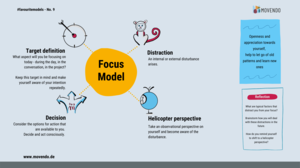#favouritemodel No. 9 - Focus Model

At the beginning of the day, we set ourselves certain goals and know which to-do's we want to have checked off by the end of the day. But as soon as the first phone calls, the first little everyday "disasters" hit us, our focus is quickly lost and we float with the current of new impulses. We switch into a kind of autopilot mode in which we follow the external or internal distractions and no longer make conscious decisions. The focus model can help to sharpen and consciously set your own focus at any time.
Step 1: Set your personal goal, for example: In the employee appraisal, I want to concentrate fully on my employee and find out how he or she is doing in the current project.
Step 2: If you notice a distraction from the outside (for example, the phone ringing) or from the inside (for example, you suddenly find yourself thinking about the next important project meeting, for which you still have to finalise your presentation), it is an important step to simply notice and acknowledge these distractions. Meeting distractions with curiosity and appreciation is crucial to returning to your own focus.
Step 3: Once you have consciously noticed a distraction, you have a choice. You can make a conscious decision about your next steps and consciously set your focus again. Do I take the phone call? Do I play through the next meeting in my mind? Or do I devote myself to my colleague again and listen to him or her with full attention?
Helpful in the use of the focus model:
- Reflect for yourself on what your typical internal or external "distractors" are and how you can counter them in your daily life.
- Think of focusing as a recurring exercise and routine: whenever you lose focus (for whatever reason), start again from the beginning.
- Make it a daily routine to observe your actions from a helicopter perspective. In this way, you will be able to notice distractions in between and refocus yourself.











